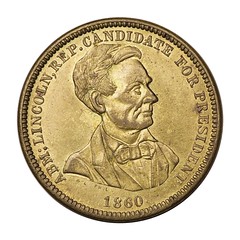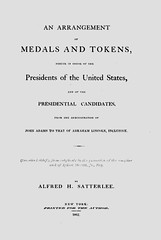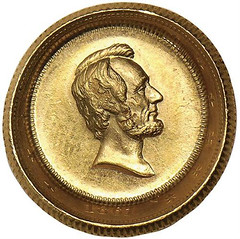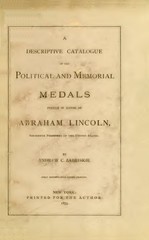
PREV ARTICLE
NEXT ARTICLE
FULL ISSUE
PREV FULL ISSUE
BOOK REVIEW: MORE ON ABRAHAM LINCOLN - BEYOND THE AMERICAN ICON
Here's my take on the new Reed book, Abraham Lincoln - Beyond the American Icon.
-Editor
From the Foreword by Q. David Bowers: If anyone is qualified to break new ground in Lincoln scholarship, it is Fred Reed. I have been a friend of Fred’s for many years, since the 1960s in fact, and have followed his award-winning career. A consummate researcher and a gifted writer, he has created standard reference articles and books on several historical subjects, his Abraham Lincoln: The Image of His Greatness being a recent example. Both broad and deep in its scope, that book was recognized with literary awards from national organizations representing several branches of numismatics. Beyond that, it has been embraced by the mainstream of the Lincoln research community, as well as by more casual armchair historians and Lincoln fans. Now, in his latest work, Abraham Lincoln: Beyond the American Icon, Reed has created a perspective of Lincoln from a new angle: Lincoln seen not from the viewpoint of military history or presidential accomplishments, but as he was regarded by the American public in his time, followed by his legacy since 1865. In many ways Fred Reed’s new book adds to the appreciation of Lincoln as a human being. In the years after the president’s passing, satire was rare, and appreciation, indeed adulation, was common. For an artist or sculptor to be commissioned to create a statue, plaque, coin, or other item depicting Lincoln was a high tribute. Reed traces the shift in public opinion that has resulted in occasional contrarian depictions of Lincoln as secretly gay or racist, showing how the once universally revered president has become touched by controversy and parody, and yet endures as one of the most fascinating figures in our collective history. Lincoln’s image has become so familiar to Americans that the beloved president has been increasingly called upon to serve any number of agendas, from the “Honest Abe” persona that advertisers and business owners appropriate in order to gain credibility and the public’s trust, to the rawboned pioneer scrapper, who is called upon to bodyslam evildoers in graphic novels and films. From Fred Reed's Introduction: Abraham Lincoln: Beyond the American Icon gives me an opportunity to amplify and extend on previous commentary; in short, to draw a finer point to the first book’s arguments. It also provides an opportunity to drill down on certain aspects treated cursorily in the first text, and present interesting additional data or details (such as the Henry Clay medal presented by Daniel Ullman to Lincoln, or the City of Lincoln, Nebraska, municipal scrip with Lincoln portraits), and to show interesting different varieties/types of previously illustrated Lincolniana. Furthermore, this book presents the opportunity to put down on the record a broad canvas of celebrations surrounding the Lincoln bicentennial. We might wish that someone had done as much a century ago, shortly after the Lincoln centennial!
Below are some selected images and captions from the book. Thanks again to Fred Reed and Whitman Publishing for their permission and assistance. A couple treats for numismatic bibliophiles are included.
-Editor
The Numismatic Bibliomania Society is a non-profit organization promoting numismatic literature. See our web site at coinbooks.org. To submit items for publication in The E-Sylum, write to the Editor at this address: whomren@gmail.com To subscribe go to: https://my.binhost.com/lists/listinfo/esylum All Rights Reserved. NBS Home Page Contact the NBS webmaster 
|





